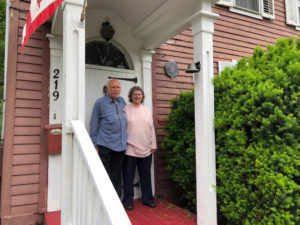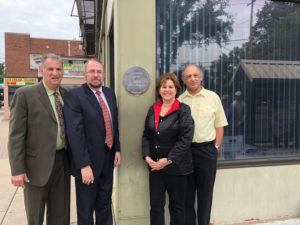
The West Haven Historical Society and the West Haven Rotary Club are pleased to announce a joint partnership placing historic markers on the exterior of historical homes and commercial property throughout the city. The granite plaques will commemorate the date when the building or home was constructed and the name of the first occupant or original owner of the property.
“We are grateful to the Rotary Club for agreeing to work with us to have the plaques made and installed at various sites in West Haven,” said Jon Purmont, President of the Historical Society. “We believe since West Haven is one of Connecticut’s oldest settlements (1648) it was important to recognize many of the city’s landmark historic homes and structures with an historical marker.”

Rotary Club President Dianne Milano noted that she is “pleased that the program has started and Rotary is proud to be working with the Historical Society in their efforts to designate homes and business structures throughout the city.”
Among the first properties designated for the granite markers are the Thompson Block (1874) at 509 Campbell Ave. today owned by the Altschuler family and the home at 219 Court St. (1796) currently the residence of William and Nancy Barr.
The two historic structures represent significant architectural features according to Robert Grestini, coordinator of the project, who researched information on the sites which are detailed in the State Historic Resources Inventory. The Thompson Block (1874) remains one of the oldest structures in downtown West Haven.
“Erected by Silas Thompson it is a three-story large brick edifice, Italianate in character featuring very wide overhanging eaves, a low-pitched hip roof and a rectangular shape. Because of its desirable location, the building has had a rich and colorful past,” according to the State Historical Inventory’s description.
Town offices were located for many years on the second floor along with other tenants including the Masons, Knights of Pythias, West Haven’s Catholic community, West Haven Bank and Trust Company, Post Office, Feinson’s Department store, and the Paier Art College was located there.
The property at the Court Street location, built in 1796, is a two-story dwelling.
“It has a heavy-timber frame with narrow clap-board siding and side-gabled roofline. First floor windows are extremely tall French windows capped by fixed transoms,” according to the Inventory. In addition, “the house is a modest residence which represents an architecturally significant example of 18th century vernacular design.”
Originally the house was located on Savin Avenue and moved to its present location around the turn of the 20th century.
The two structures join the Poli House at 686 Savin Ave., home of the Historical Society, as the first sites to be designated “Historical Treasures of West Haven.”
Other homes and commercial buildings throughout the city will be selected for consideration and designation as historically significant.
By marking these properties “we hope to make West Haven residents and visitors more aware of the distinctive history and architectural styles of the various homes and commercial structures throughout the city,” Grestini explained.